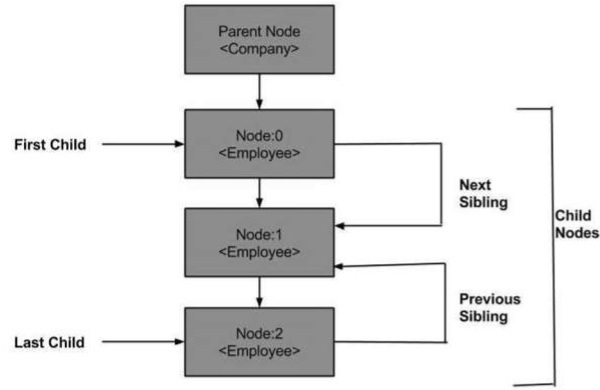
- XML DOM 基礎
- XML DOM - 首頁
- XML DOM - 概述
- XML DOM - 模型
- XML DOM - 節點
- XML DOM - 節點樹
- XML DOM - 方法
- XML DOM - 載入
- XML DOM - 遍歷
- XML DOM - 導航
- XML DOM - 訪問
- XML DOM 操作
- XML DOM - 獲取節點
- XML DOM - 設定節點
- XML DOM - 建立節點
- XML DOM - 新增節點
- XML DOM - 替換節點
- XML DOM - 刪除節點
- XML DOM - 克隆節點
- XML DOM 物件
- DOM - 節點物件
- DOM - NodeList 物件
- DOM - NamedNodeMap 物件
- DOM - DOMImplementation
- DOM - DocumentType 物件
- DOM - ProcessingInstruction
- DOM - 實體物件
- DOM - 實體引用物件
- DOM - 符號物件
- DOM - 元素物件
- DOM - 屬性物件
- DOM - CDATASection 物件
- DOM - 註釋物件
- DOM - XMLHttpRequest 物件
- DOM - DOMException 物件
- XML DOM 有用資源
- XML DOM - 快速指南
- XML DOM - 有用資源
- XML DOM - 討論
XML DOM - 導航
到目前為止,我們學習了 DOM 結構,如何載入和解析 XML DOM 物件以及遍歷 DOM 物件。在這裡,我們將瞭解如何在 DOM 物件中節點之間進行導航。XML DOM 包含節點的各種屬性,這些屬性可以幫助我們遍歷節點,例如:
- parentNode
- childNodes
- firstChild
- lastChild
- nextSibling
- previousSibling
以下是節點樹的示意圖,顯示了它與其他節點的關係。

DOM - 父節點
此屬性將父節點指定為節點物件。
示例
以下示例 (navigate_example.htm) 將 XML 文件 (node.xml) 解析為 XML DOM 物件。然後,透過子節點導航到父節點:
<!DOCTYPE html>
<html>
<body>
<script>
if (window.XMLHttpRequest) {
xmlhttp = new XMLHttpRequest();
} else {
xmlhttp = new ActiveXObject("Microsoft.XMLHTTP");
}
xmlhttp.open("GET","/dom/node.xml",false);
xmlhttp.send();
xmlDoc = xmlhttp.responseXML;
var y = xmlDoc.getElementsByTagName("Employee")[0];
document.write(y.parentNode.nodeName);
</script>
</body>
</html>
如上例所示,子節點 Employee 導航到其父節點。
執行
將此檔案另存為伺服器路徑上的 navigate_example.html(此檔案和 node.xml 應位於伺服器上的同一路徑)。在輸出中,我們得到 Employee 的父節點,即 Company。
第一個子節點
此屬性的型別為 Node,表示 NodeList 中存在的第一個子節點名稱。
示例
以下示例 (first_node_example.htm) 將 XML 文件 (node.xml) 解析為 XML DOM 物件,然後導航到 DOM 物件中存在的第一個子節點。
<!DOCTYPE html>
<html>
<body>
<script>
if (window.XMLHttpRequest) {
xmlhttp = new XMLHttpRequest();
} else {
xmlhttp = new ActiveXObject("Microsoft.XMLHTTP");
}
xmlhttp.open("GET","/dom/node.xml",false);
xmlhttp.send();
xmlDoc = xmlhttp.responseXML;
function get_firstChild(p) {
a = p.firstChild;
while (a.nodeType != 1) {
a = a.nextSibling;
}
return a;
}
var firstchild = get_firstChild(xmlDoc.getElementsByTagName("Employee")[0]);
document.write(firstchild.nodeName);
</script>
</body>
</html>
函式 get_firstChild(p) 用於避免空節點。它有助於從節點列表中獲取 firstChild 元素。
x = get_firstChild(xmlDoc.getElementsByTagName("Employee")[0]) 獲取標籤名稱為 Employee 的第一個子節點。
執行
將此檔案另存為伺服器路徑上的 first_node_example.htm(此檔案和 node.xml 應位於伺服器上的同一路徑)。在輸出中,我們得到 Employee 的第一個子節點,即 FirstName。
最後一個子節點
此屬性的型別為 Node,表示 NodeList 中存在的最後一個子節點名稱。
示例
以下示例 (last_node_example.htm) 將 XML 文件 (node.xml) 解析為 XML DOM 物件,然後導航到 xml DOM 物件中存在的最後一個子節點。
<!DOCTYPE html>
<body>
<script>
if (window.XMLHttpRequest) {
xmlhttp = new XMLHttpRequest();
} else {
xmlhttp = new ActiveXObject("Microsoft.XMLHTTP");
}
xmlhttp.open("GET","/dom/node.xml",false);
xmlhttp.send();
xmlDoc = xmlhttp.responseXML;
function get_lastChild(p) {
a = p.lastChild;
while (a.nodeType != 1){
a = a.previousSibling;
}
return a;
}
var lastchild = get_lastChild(xmlDoc.getElementsByTagName("Employee")[0]);
document.write(lastchild.nodeName);
</script>
</body>
</html>
執行
將此檔案另存為伺服器路徑上的 last_node_example.htm(此檔案和 node.xml 應位於伺服器上的同一路徑)。在輸出中,我們得到 Employee 的最後一個子節點,即 Email。
下一個兄弟節點
此屬性的型別為 Node,表示下一個子節點,即 NodeList 中存在的指定子元素的下一個兄弟節點。
示例
以下示例 (nextSibling_example.htm) 將 XML 文件 (node.xml) 解析為 XML DOM 物件,該物件立即導航到 xml 文件中存在的下一個節點。
<!DOCTYPE html>
<body>
<script>
if (window.XMLHttpRequest) {
xmlhttp = new XMLHttpRequest();
}
else {
xmlhttp = new ActiveXObject("Microsoft.XMLHTTP");
}
xmlhttp.open("GET","/dom/node.xml",false);
xmlhttp.send();
xmlDoc = xmlhttp.responseXML;
function get_nextSibling(p) {
a = p.nextSibling;
while (a.nodeType != 1) {
a = a.nextSibling;
}
return a;
}
var nextsibling = get_nextSibling(xmlDoc.getElementsByTagName("FirstName")[0]);
document.write(nextsibling.nodeName);
</script>
</body>
</html>
執行
將此檔案另存為伺服器路徑上的 nextSibling_example.htm(此檔案和 node.xml 應位於伺服器上的同一路徑)。在輸出中,我們得到 FirstName 的下一個兄弟節點,即 LastName。
上一個兄弟節點
此屬性的型別為 Node,表示上一個子節點,即 NodeList 中存在的指定子元素的上一個兄弟節點。
示例
以下示例 (previoussibling_example.htm) 將 XML 文件 (node.xml) 解析為 XML DOM 物件,然後導航到 xml 文件中最後一個子節點之前的節點。
<!DOCTYPE html>
<body>
<script>
if (window.XMLHttpRequest)
{
xmlhttp = new XMLHttpRequest();
} else {
xmlhttp = new ActiveXObject("Microsoft.XMLHTTP");
}
xmlhttp.open("GET","/dom/node.xml",false);
xmlhttp.send();
xmlDoc = xmlhttp.responseXML;
function get_previousSibling(p) {
a = p.previousSibling;
while (a.nodeType != 1) {
a = a.previousSibling;
}
return a;
}
prevsibling = get_previousSibling(xmlDoc.getElementsByTagName("Email")[0]);
document.write(prevsibling.nodeName);
</script>
</body>
</html>
執行
將此檔案另存為伺服器路徑上的 previoussibling_example.htm(此檔案和 node.xml 應位於伺服器上的同一路徑)。在輸出中,我們得到 Email 的上一個兄弟節點,即 ContactNo。